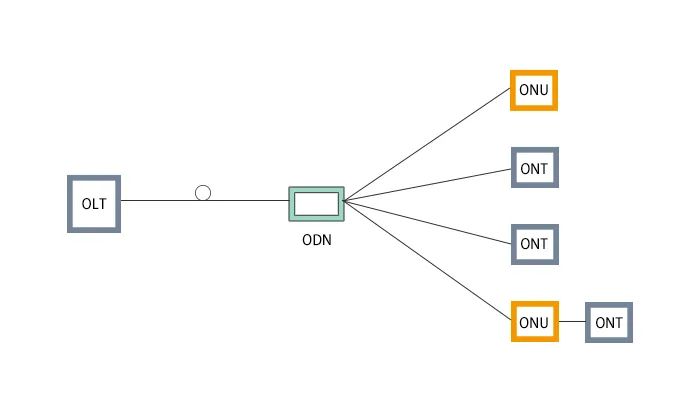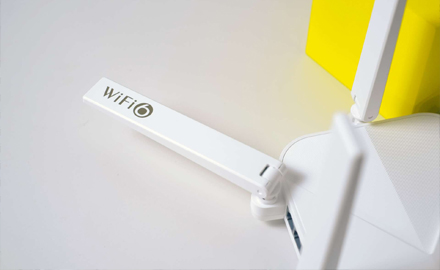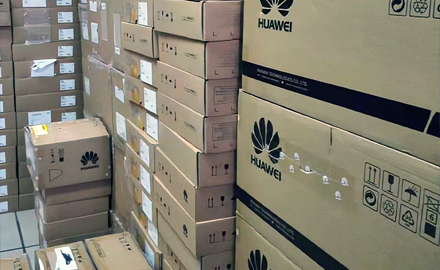Optical access network is an access network that uses light as the transmission medium, replacing copper wires, and is used to access every home. Optical access network. The optical access network generally consists of three parts: optical line terminal OLT, optical network unit ONU, and optical distribution network ODN. OLT and ONU are the core components of the optical access network.
OLT

The full name of OLT is Optical Line Terminal, optical line terminal. OLT is an optical line terminal, which is the central office equipment of telecommunications. It is used to connect optical fiber trunk lines. It functions as a switch or router in a traditional communication network. It is a device for the entrance and exit of the external network and the internal network. Placed at the central office, the most important execution functions are traffic scheduling, buffer control, and providing user-oriented passive optical fiber network interfaces and allocating bandwidth. Simply put, it implements two functions. For the upstream, it completes the uplink access to the PON network; for the downstream, it sends and distributes the acquired data to all ONU user terminal devices through the ODN network.
ONU

ONU is Optical Network Unit. The ONU has two functions: it selectively receives the broadcasts sent by the OLT, and responds to the OLT if it needs to receive the data; it collects and caches the Ethernet data that the user needs to send, and sends it to the OLT according to the assigned sending window. Send this cached data. Different deployment methods of ONU access in FTTx networks are also different. For example, FTTC (Fiber To The Curb): ONU is placed in the central computer room of the community; FTTB (Fiber To The Building): ONU is placed in the junction box of the corridor; FTTH (Fiber To The Home): ONU is placed in the home user.
ONT
ONT is Optical Network Terminal, the terminal unit of FTTH, commonly known as "optical modem", similar to xDSL electric modem. ONT is an optical network terminal, which is used by end users, while ONU refers to an optical network unit, and there may be other networks between it and the end user. ONT is a component of ONU.
The relationship between ONU and OLT
OLT is the management end, and ONU is the terminal; ONU service provisioning is issued through the OLT, and the two have a master-slave relationship. Multiple ONUs can be connected to one OLT through an optical splitter.
ODN
ODN is Optical Distribution Network, optical distribution network, ODN is an FTTH optical cable network based on PON equipment. It is the physical optical transmission channel between OLT and ONU. Its main function is to complete the two-way transmission of optical signals. It is usually composed of optical fiber cables, optical connectors, optical splitters and supporting equipment for installing and connecting these devices. The most important components are It's a beam splitter. From a functional point of view, ODN can be divided into four parts from the central office to the user end: the feeder optical cable subsystem, the distribution optical cable subsystem, the drop optical cable subsystem and the optical fiber terminal subsystem.

In the development of FTTx, the access layer needs to build a huge optical fiber distribution network, that is, an ODN network. How to scientifically manage ODN networks has become the focus of major operators and standards organizations such as ITU-T. Just like we see barcodes on food and other commodities in supermarkets, electronic labels can be added to the optical fiber head to effectively manage the optical fiber. We call it EODN. At present, this technology has become the standard of major operators and ITU-T. The focus of discussion and attention by standards organizations. In Chapter 10.6.2 of the fourth edition of the "Computer Network" textbook published by Electronic Industry Press, ODN is understood as Optical Distribution Node, that is, optical distribution node. It refers to the optical fiber node that simulates optical fiber in HFC (Hybrid Fiber Coax, optical fiber coaxial hybrid network) and is used to connect analog optical fiber. So can we solve the two core issues of ODN management and realize automated management of ODN without changing the passive characteristics of ODN?
Huawei iODN
Huawei has proposed the iODN (Intelligent ODN) solution. In the iODN solution, ODN products have added the following intelligent features: fiber identification management, port status collection, port search instructions, visualization tool PDA, etc. The iODN solution can realize the automatic entry and management of ODN fiber connection information, ensuring the accuracy and timely synchronization of existing system information. At the same time, through the visualization software of the PDA and the intelligent LED indication on the iODN device, automatic fiber search and precise operation can be realized, greatly improving the operation and maintenance efficiency, and realizing efficient operation and maintenance of the ODN network. In addition, based on the iODN architecture, a variety of value-added applications can be developed on the basis of the existing system to realize the automation of the entire construction, operation and maintenance process.
ZTE’s eODN
ZTE launched "eODN (Easy ODN)", which is based on GIS geographical information system and R intelligent identification system. The planning, design, construction and maintenance of the ODN network cycle of this system effectively combines early planning, mid-term construction and post-maintenance. It uses non-contact intelligent systems to improve the efficiency of optical fiber management and realize the sharing and sharing of optical fiber information among various departments. Seamless transmission makes ODN network construction a dynamic virtuous cycle and ensures its sustainable development.
FiberHome’s sODN
Fiberhome Communications insists on designing products based on the actual situation of traditional ODN and proposes a complete solution of "sODN (smart ODN)". The system fully considers the operation and maintenance characteristics of existing traditional ODN, and strives to ensure that existing practitioners can easily adapt to the new ODN intelligent management model during intelligent implementation. The system has the characteristics of low power consumption, long life, and easy maintenance. It uses new information technology to make the ODN network an organic whole and improve customer perception.



 What is the Role of EDFA in FTTH?
What is the Role of EDFA in FTTH?
 The Difference Between AX1800 ONU and AX3000 ONU
The Difference Between AX1800 ONU and AX3000 ONU
 How are Huawei OLTs Classified?
How are Huawei OLTs Classified?
 The Future Trend of Optical Line Terminals (OLTs)
The Future Trend of Optical Line Terminals (OLTs)